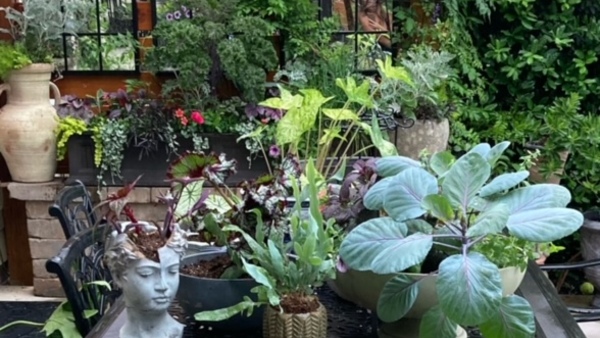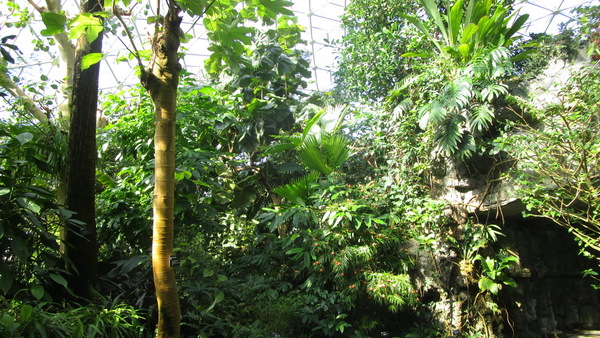
Today we’re visiting with Mariel Tribby. Mariel does most of her gardening at her job at the Missouri Botanical Garden in St. Louis, where she is in charge of the rock garden. She is also a board member of the North American Rock Garden Society, and she grows a lot of cool rock garden plants. Sometimes these plants have a reputation for being difficult to grow, but mostly they just need good drainage and good plant choices. The St. Louis area has hot, humid summers and pretty cold winters (Zone 6), but Mariel cultivates lots of great plants that love those conditions.
Note: A lot of these plants are so uncommonly grown that there isn’t a lot of information on winter hardiness, so many of the Zone rankings below are educated guesses.
 This Campanula formanekiana (Zones 6–8) is just loaded down with flowers! The species generally grows as a biennial, so this explosion of blooms may be its swan song before leaving the garden, but wow, what a beautiful display!
This Campanula formanekiana (Zones 6–8) is just loaded down with flowers! The species generally grows as a biennial, so this explosion of blooms may be its swan song before leaving the garden, but wow, what a beautiful display!
 A fly visitor is pollinating this Aristolochia tomentosa (Zones 5–8). Aristolochia’s odd flowers lure in flies with colors—and sometimes smells—that trick them into thinking the flowers are carrion that they can lay their eggs on. Once a fly crawls into the flower, backward-pointing hairs keep it trapped; as it buzzes around, it gets covered with pollen. It is only released when another fly enters that already has pollen from another flower on it. That pollinates the flower and causes the hairs to collapse, releasing the pollen-covered fly to go off and pollinate the next flower.
A fly visitor is pollinating this Aristolochia tomentosa (Zones 5–8). Aristolochia’s odd flowers lure in flies with colors—and sometimes smells—that trick them into thinking the flowers are carrion that they can lay their eggs on. Once a fly crawls into the flower, backward-pointing hairs keep it trapped; as it buzzes around, it gets covered with pollen. It is only released when another fly enters that already has pollen from another flower on it. That pollinates the flower and causes the hairs to collapse, releasing the pollen-covered fly to go off and pollinate the next flower.
 Globularia punctata (Zones 3–8) looks beautiful in the morning light. This plant forms a low cushion or carpet with these blue blooms in spring.
Globularia punctata (Zones 3–8) looks beautiful in the morning light. This plant forms a low cushion or carpet with these blue blooms in spring.
 Penstemon cobaea (Zones 5–8) is in full bloom. There are nearly 300 different species of penstemon, native mostly to western North America, and many of them are beautiful additions to the garden. Most, but not all, require well-drained soil to thrive.
Penstemon cobaea (Zones 5–8) is in full bloom. There are nearly 300 different species of penstemon, native mostly to western North America, and many of them are beautiful additions to the garden. Most, but not all, require well-drained soil to thrive.
 Mariel says she’s a big fan of Dracocephalum ruyschiana (Zones 3–7), as it is easy to grow and not overly vigorous or aggressive, despite being in the mint family.
Mariel says she’s a big fan of Dracocephalum ruyschiana (Zones 3–7), as it is easy to grow and not overly vigorous or aggressive, despite being in the mint family.
 There is a whole world of little rock garden irises. This is Iris timofejewii (Zones 4–8) with the bright yellow Aurinia saxatilis (Zones 3–7) behind it. What an amazing color combination!
There is a whole world of little rock garden irises. This is Iris timofejewii (Zones 4–8) with the bright yellow Aurinia saxatilis (Zones 3–7) behind it. What an amazing color combination!
 Pulsatilla (Zones 4–8) emerge with their incredibly fuzzy new leaves and flowers early in the spring. These emerged so early that they caught a dusting of late snow on their blooms.
Pulsatilla (Zones 4–8) emerge with their incredibly fuzzy new leaves and flowers early in the spring. These emerged so early that they caught a dusting of late snow on their blooms.
 Campanula baumgartenii (Zones 4–8) and Silene schafta (Zones 3–9) grow together in a tapestry of cheery blooms.
Campanula baumgartenii (Zones 4–8) and Silene schafta (Zones 3–9) grow together in a tapestry of cheery blooms.
If you want to see more from Mariel, check out her Instagram: @rockeryplantess
Have a garden you’d like to share?
Have photos to share? We’d love to see your garden, a particular collection of plants you love, or a wonderful garden you had the chance to visit!
To submit, send 5-10 photos to [email protected] along with some information about the plants in the pictures and where you took the photos. We’d love to hear where you are located, how long you’ve been gardening, successes you are proud of, failures you learned from, hopes for the future, favorite plants, or funny stories from your garden.
Have a mobile phone? Tag your photos on Facebook, Instagram or Twitter with #FineGardening!
Do you receive the GPOD by email yet? Sign up here.

















Comments
Wow, so many beautiful, unusual and interesting plants and information!
Very interesting post!
So very beautiful - that bloom laden campanula is almost unbelievable. These photos brightened my day!!
That beautiful display of campanula sprawling over the rocks literally made me sit up and take notice! Everything looks so interesting!
Log in or create an account to post a comment.
Sign up Log in